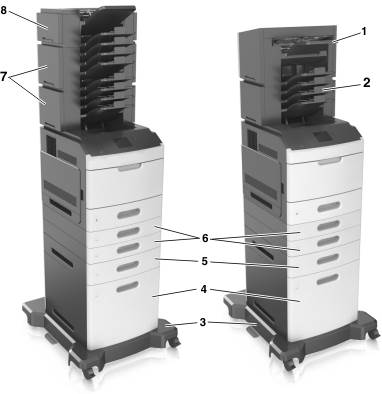You don't necessarily need to have a complex device like this…

…to be concerned about the selection of input and output trays.
Nearly all workplace printers and modern multifunction devices have more than one input tray for paper; often they support multiple output trays as well. One reason is that many applications and business processes need different paper types and/or paper sizes. A different color for an urgent notice here, a perforated sheet for a customer invoice there, a custom printed envelope with which to send both of these documents… you get the picture.
When a business process necessitates a different paper stock, you can usually specify within the source application, at the logical page level, which paper size to use. However, the specific tray selection is not always that easy to control, because there is no agreed-upon standard to identify an input or output tray in all the different devices. Each hardware vendor does things a different way. This leaves things up to the print driver to properly manage tray selection, for example, in the case of Windows or SAP environments that use specially-developed drivers to process native print requests.
Printer Command Language (PCL) a popular page description language for print devices, tries to harmonize this process by allowing for “logical tray” selection to tell the physical device which input tray to use for a given print process (as well as which output tray the finished document should go to). However, it is unlikely that these logical tray numbers are the ones indicated on the physical printer tray itself. Even worse, not all vendors and printers use the same logical numbers. PostScript is a popular alternative to PCL that offers a similar approach to the challenge of printer tray selection. Unfortunately, it does not introduce any significant improvement in this process.
As you see, it can become a nightmare to identify the logical number for the tray you'd like to use. And if you have to repeat the process for a large fleet of different printers and multifunction devices in your organization, you may begin to feel a bit mad. What’s worse, the moment you buy new print devices to replace older or broken ones, you'll have to start it all again from the beginning.
Today, almost all print devices let you request Auto Tray Selection of the logical tray, although not all vendors and models use the same logical number to identify this "magic tray." The Auto Tray Select option places the burden on the printer to select the correct input tray based on the paper attribute defined in the incoming spool file. However, this magic selection has the same difficulties in terms of determining the logical number of the Auto Tray. It also limits the selection criteria to paper sizes, and cannot specify properties of the paper like color, watermarked or glossy paper, etc.
Tray selection the SAP way
In an SAP application environment, the SAP Generic Output Format (SAPGOF) standard uses a specific way to denote the input and output trays:
- TRY01 Paper tray 1
- TRY02 Paper tray 2
- TRY03 Paper tray 3
- TRY04 Paper tray 4
- TRYMN Manual paper feed
- TRYEN Envelope feed
- TRYME Manual envelope feed
In essence, SAP relies on printer drivers to handle the complex task of associating the logical number of the device's tray to the one specified within SAPGOF data stream. However, these printer drivers are not always updated and accurate for that SAP instance.
LRS Enterprise Output Management software simplifies the way you manage requirements for tray selection, allowing you to logically decouple the business applications that produce your critical reports from the physical devices in your printer fleet. As a result, the applications no longer need to worry about which final destination device the reports should be addressed to.
First of all, LRS Transform software perfectly understands any data stream command that selects a specific tray and preserves this information in the output data stream itself. The software also gives you the flexibility to configure each transform for each physical device (server queue) to map the correct physical printer tray based on the specified input logical tray number.
When dealing specifically with SAPGOF data produced by SAP application servers, LRS offers many different OTF2xxx Transforms that generate output in all standard printer language formats (e.g., PCL, PostScript, etc.). This helps you meet your requirements even in the case of heterogeneous printer fleets, allowing you to match logical to physical trays without the use of SAP-specific drivers.
If you are very fortunate, you may not need any data stream conversions since your applications already generate the output in a printer-ready format. In this case, you may still want to use the LRS Output Management solution to take advantage of so-called PCMD (Print Command) functionality. The advanced PCMD feature sends the physical device one or more commands before transmitting the real spool file to the printer. This gives you the chance to alter the contents of the data stream in case it isn't appropriate for that specific device. For example, you may have a handful of devices that behave differently from the rest of your fleet in terms of tray selection. Using PCMDs, you can utilize default settings for most application printing and let LRS software manage the exceptions.
Last, but not least, the LRS Output Manager solution provides the capability to invoke an external process before sending the spool file to its final destination. You can pass the spool data itself along with all associated attributes so that the external process can manipulate the data stream for any complex business requirement. This gives your output management system a flexible and powerful way to address any tray selection criteria needed to support your business stakeholders.
From the simplest to the most complex requirement, LRS Enterprise Output Management solutions help you manage them without putting your business at risk!